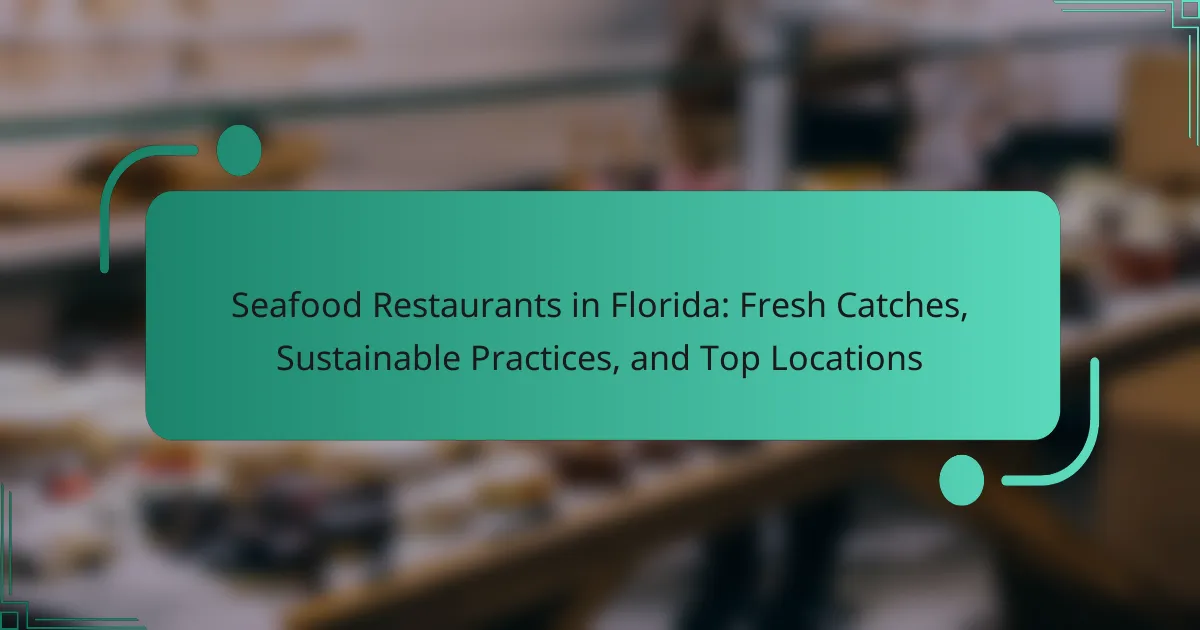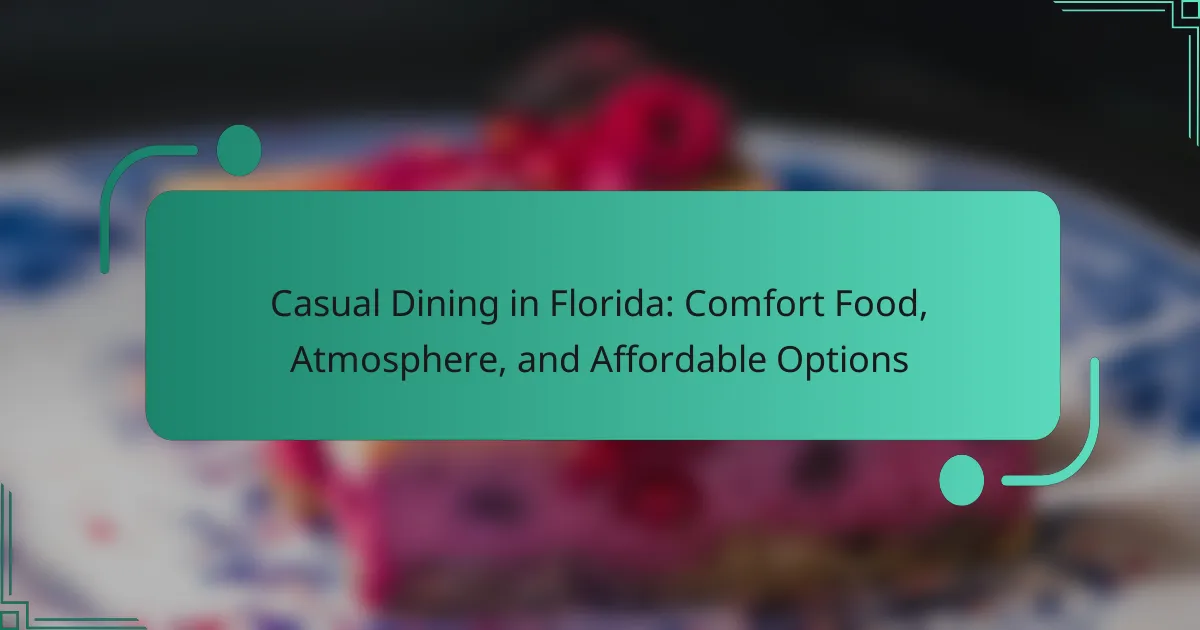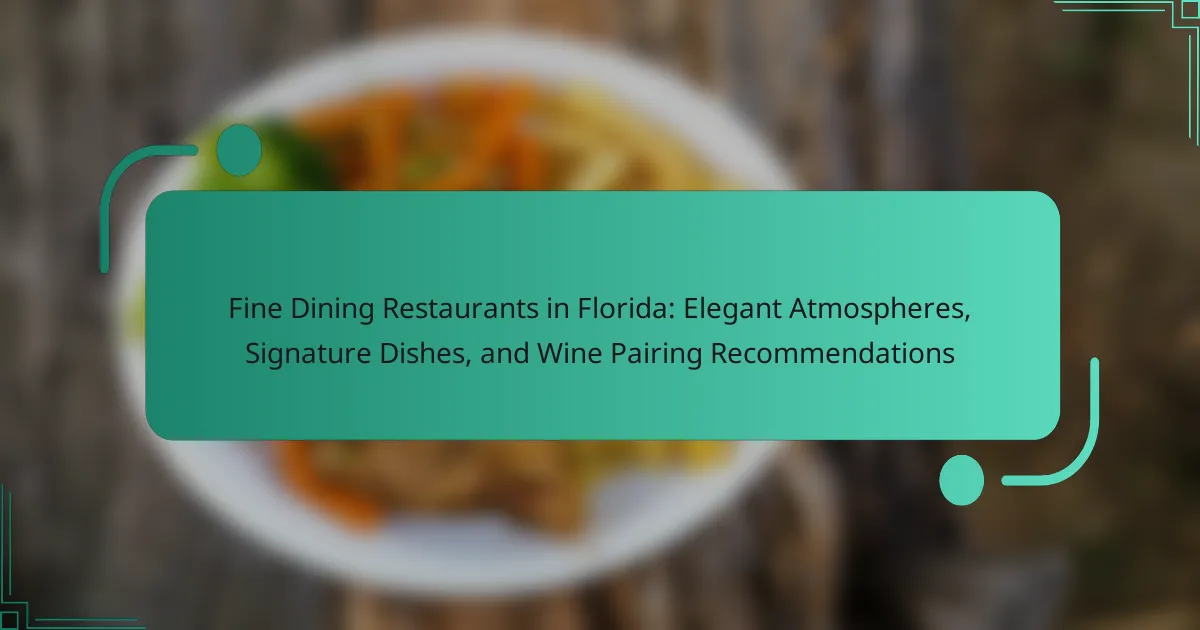Seafood restaurants in Florida specialize in offering a variety of seafood dishes, including fresh fish, shellfish, and other marine life, sourced from the state’s extensive coastline. These establishments emphasize sustainability by sourcing seafood from responsible fisheries and local suppliers, often featuring seasonal menus that highlight the local catch. Major seafood dining locations include Key West, Tampa, and Miami, each known for unique culinary experiences and vibrant dining scenes. Additionally, many seafood restaurants engage in community education about sustainable seafood choices and implement waste reduction practices to promote responsible consumption. The seafood industry plays a significant role in Florida’s economy, contributing billions annually.
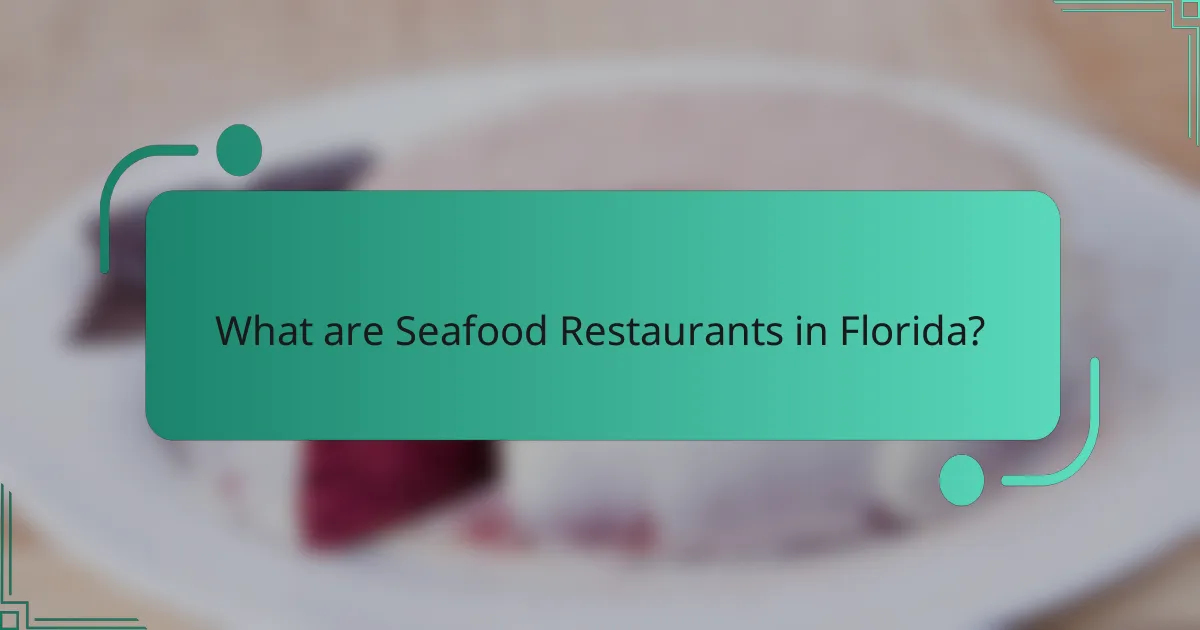
What are Seafood Restaurants in Florida?
Seafood restaurants in Florida are dining establishments that specialize in serving seafood dishes. These restaurants offer a variety of fresh catches, including fish, shellfish, and other marine life. Florida’s extensive coastline provides access to a diverse range of seafood options. Many seafood restaurants focus on sustainability and sourcing local ingredients. Popular seafood dishes include grouper sandwiches, shrimp tacos, and stone crab claws. According to the Florida Department of Agriculture, seafood is a significant part of the state’s culinary culture. The state’s seafood industry contributes billions to the economy annually. These restaurants are often located near coastal areas, enhancing the dining experience with scenic views.
How do Seafood Restaurants in Florida differ from other dining establishments?
Seafood restaurants in Florida differ from other dining establishments primarily due to their focus on fresh, locally sourced seafood. These restaurants often feature daily catches from the surrounding waters, ensuring freshness and quality. Many establishments emphasize sustainable fishing practices to protect marine ecosystems. This commitment to sustainability sets them apart from typical dining options. Additionally, Florida seafood restaurants frequently incorporate regional flavors and cooking styles. They offer unique dishes that highlight the local culinary heritage. The coastal location of these restaurants allows for direct access to a variety of seafood. This accessibility enhances the dining experience with seasonal specialties. Overall, Florida seafood restaurants uniquely blend fresh ingredients, sustainability, and local culture.
What types of seafood are commonly featured on menus?
Common types of seafood featured on menus include fish, shellfish, and crustaceans. Fish varieties often include salmon, tuna, and snapper. Shellfish options typically comprise shrimp, scallops, and clams. Crustaceans such as crab and lobster are also popular. These seafood items are frequently sourced fresh to enhance flavor and quality. Many restaurants emphasize sustainability in their seafood selections. This approach aligns with consumer demand for environmentally responsible dining choices.
How do regional flavors influence seafood dishes in Florida?
Regional flavors significantly influence seafood dishes in Florida. The state’s diverse culinary landscape reflects its cultural heritage and geographic location. Florida’s seafood often incorporates influences from Caribbean, Latin American, and Southern cuisines. Ingredients like citrus, spices, and tropical fruits are commonly used. For example, the use of key lime juice enhances the flavor of fish dishes. Additionally, local herbs like cilantro and parsley add freshness. The state’s fishing communities also emphasize seasonal and sustainable catches. This ensures that seafood dishes remain vibrant and representative of local traditions. Overall, regional flavors create a unique dining experience in Florida’s seafood restaurants.
Why is Florida known for its seafood dining experience?
Florida is known for its seafood dining experience due to its extensive coastline and rich marine biodiversity. The state’s waters provide a variety of fresh seafood, including shrimp, grouper, and stone crab. Florida’s warm climate supports year-round fishing, ensuring a consistent supply of fresh catches. Additionally, many seafood restaurants emphasize sustainable practices, sourcing their seafood responsibly. The state’s culinary scene showcases diverse regional dishes influenced by local cultures. Florida hosts numerous seafood festivals, attracting visitors and highlighting its seafood heritage. These factors contribute to Florida’s reputation as a premier seafood dining destination.
What geographic factors contribute to the abundance of fresh seafood?
Coastal proximity significantly contributes to the abundance of fresh seafood. Regions near oceans and seas provide direct access to marine life. The Gulf of Mexico, for example, is rich in diverse fish species. Nutrient-rich waters support the growth of various seafood. Ocean currents also play a role in distributing nutrients. Estuaries create productive environments for young fish. These geographic features lead to higher seafood availability. Florida’s extensive coastline enhances its seafood resources.
How does Florida’s fishing industry support local restaurants?
Florida’s fishing industry supports local restaurants by providing fresh seafood directly from local waters. This access to fresh fish enhances menu offerings and attracts customers seeking quality dining experiences. Local restaurants often source their seafood from nearby fisheries, ensuring freshness and supporting the local economy. According to the Florida Fish and Wildlife Conservation Commission, commercial fishing contributes billions to the state’s economy. This economic impact translates to increased business for restaurants that feature local catches. Additionally, sustainable fishing practices promoted in Florida help ensure a consistent supply of seafood for restaurants. This relationship fosters a community-oriented dining scene that benefits both fishermen and restaurateurs.
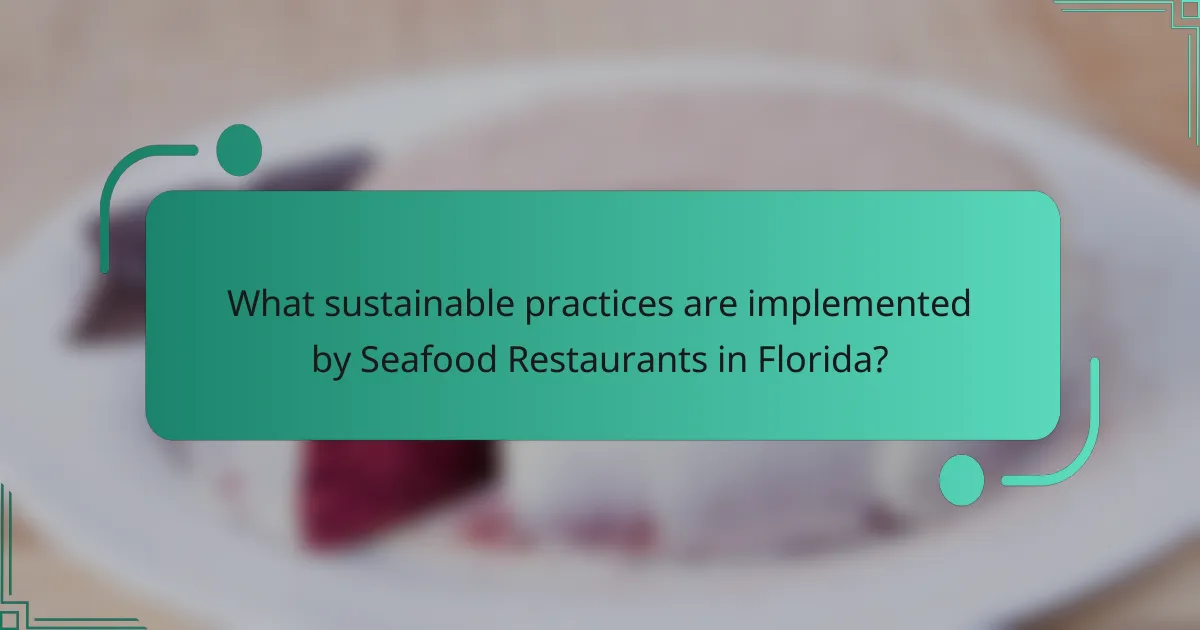
What sustainable practices are implemented by Seafood Restaurants in Florida?
Seafood restaurants in Florida implement several sustainable practices. They prioritize sourcing seafood from fisheries that follow sustainable fishing guidelines. Many restaurants participate in programs like the Marine Stewardship Council certification. This ensures that the seafood is harvested responsibly.
Additionally, some establishments focus on local sourcing to reduce carbon footprints. They often feature seasonal menus that highlight local catch. Many seafood restaurants also practice waste reduction techniques. These include composting and recycling efforts in their operations.
Furthermore, some restaurants engage in community education about sustainable seafood choices. They may host events or provide resources to inform customers. These practices collectively contribute to the sustainability of seafood consumption in Florida.
How do restaurants ensure the seafood they serve is sustainably sourced?
Restaurants ensure the seafood they serve is sustainably sourced by following strict procurement guidelines. They often partner with certified suppliers who adhere to sustainable fishing practices. Many restaurants look for seafood certified by organizations like the Marine Stewardship Council (MSC) or the Aquaculture Stewardship Council (ASC). These certifications guarantee that the seafood is harvested in a way that maintains fish populations and ecosystems. Additionally, restaurants may conduct regular audits of their suppliers to ensure compliance with sustainability standards. Some establishments also prioritize local sourcing to reduce the carbon footprint associated with transportation. By implementing these practices, restaurants contribute to the long-term health of marine environments.
What certifications should consumers look for when choosing seafood?
Consumers should look for certifications such as the Marine Stewardship Council (MSC) and the Aquaculture Stewardship Council (ASC) when choosing seafood. The MSC certification indicates that seafood is sustainably sourced from wild fisheries. The ASC certification signifies responsible aquaculture practices. Both certifications ensure adherence to environmental and social standards. These organizations assess fisheries and farms for sustainability criteria. They also promote traceability in the seafood supply chain. Choosing certified seafood supports sustainable fishing practices. It helps protect marine ecosystems and ensures fish populations remain healthy.
How do local fisheries contribute to sustainable seafood practices?
Local fisheries contribute to sustainable seafood practices by promoting responsible fishing methods. They often implement catch limits to prevent overfishing. This ensures fish populations remain healthy and abundant. Local fisheries also focus on selective fishing techniques. These methods reduce bycatch and protect non-target species. Additionally, they support habitat preservation. Healthy ecosystems are vital for sustaining fish populations. Local fisheries often engage in community education initiatives. These programs raise awareness about sustainable practices. Studies show that local fisheries can enhance local economies while maintaining ecological balance.
Why is sustainability important in the seafood restaurant industry?
Sustainability is crucial in the seafood restaurant industry to ensure the long-term viability of fish populations. Overfishing and harmful fishing practices threaten marine ecosystems. Sustainable practices help protect biodiversity and maintain healthy fish stocks. According to the Marine Stewardship Council, sustainable seafood sourcing can reduce the impact on ocean health. Restaurants adopting sustainable practices attract environmentally conscious consumers. This approach can enhance brand reputation and customer loyalty. In Florida, sustainability aligns with local regulations promoting responsible fishing. Ultimately, sustainability supports both the industry and the environment.
What impact does overfishing have on marine ecosystems?
Overfishing significantly disrupts marine ecosystems. It leads to the depletion of fish populations, which are crucial for maintaining ecological balance. When key species are overfished, it can result in the collapse of food webs. This collapse affects predator species that rely on those fish for survival. Additionally, overfishing can cause habitat destruction. Techniques such as bottom trawling damage seafloor habitats. The loss of biodiversity is another critical consequence. A study by the Food and Agriculture Organization states that overfishing has caused a decline in global fish stocks by 30%. This decline threatens the sustainability of marine resources.
How can consumers support sustainable seafood practices?
Consumers can support sustainable seafood practices by choosing seafood certified by organizations like the Marine Stewardship Council (MSC). These certifications indicate that the seafood is sourced from sustainable fisheries. Consumers should also prioritize local seafood to reduce carbon footprints associated with transportation. Additionally, avoiding overfished species helps maintain fish populations. Educating themselves about seafood sustainability increases informed purchasing decisions. Supporting restaurants that emphasize sustainable sourcing encourages the industry to adopt better practices. According to the National Oceanic and Atmospheric Administration (NOAA), sustainable seafood choices help protect marine ecosystems.
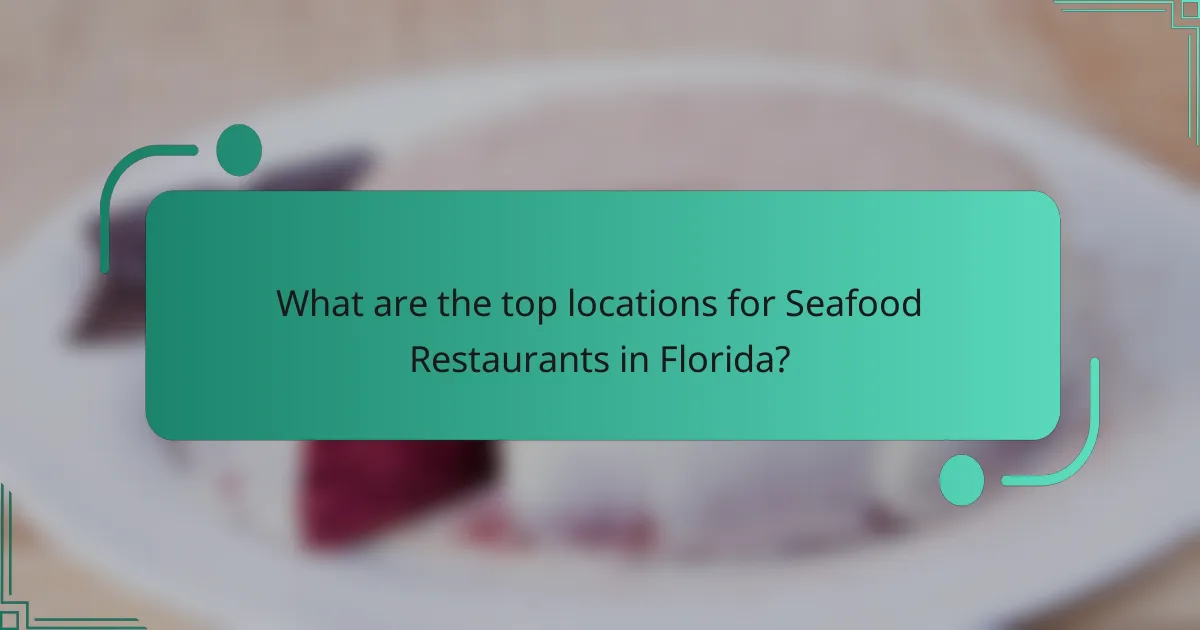
What are the top locations for Seafood Restaurants in Florida?
The top locations for seafood restaurants in Florida include Key West, Tampa, and Miami. Key West is known for its fresh catch and vibrant dining scene. Tampa offers a mix of casual and upscale seafood options. Miami boasts a diverse range of seafood cuisines influenced by Latin flavors. Other notable areas include St. Petersburg, known for its waterfront dining, and Jacksonville, which features a variety of seafood eateries along the coast. These locations are recognized for their quality seafood and unique culinary experiences.
Which cities are renowned for their seafood dining options?
Miami, New Orleans, Seattle, and Boston are renowned for their seafood dining options. Miami offers a blend of Latin flavors with fresh catches. New Orleans is famous for its Creole and Cajun seafood dishes. Seattle is known for its sustainable seafood practices and fresh Pacific catches. Boston boasts traditional New England seafood, including clam chowder and lobster rolls. Each city has a rich culinary heritage that emphasizes local seafood.
What unique seafood experiences can be found in Miami?
Miami offers unique seafood experiences such as dining at the historic Joe’s Stone Crab, renowned for its fresh stone crab claws. The restaurant has been serving customers since 1913, highlighting its long-standing reputation. Another experience is the seafood market at The Fish House, where patrons can choose live seafood and have it prepared on-site. The city’s vibrant food scene includes the annual South Beach Seafood Festival, which showcases local chefs and seafood vendors. Miami also features unique fusion dishes, blending Caribbean and Latin flavors with fresh seafood. The city’s diverse culinary landscape ensures a variety of seafood options, from upscale dining to casual eateries. The combination of fresh catches and cultural influences creates a distinctive seafood experience in Miami.
How does Key West’s seafood scene reflect local culture?
Key West’s seafood scene reflects local culture through its emphasis on fresh, locally sourced ingredients. The island’s fishing history shapes its culinary offerings. Many restaurants feature dishes made from fish caught daily by local fishermen. This practice supports the community and promotes sustainability. The use of traditional cooking methods, such as grilling and frying, highlights the area’s cultural heritage. Events like the Key West Lobster Fest celebrate local seafood and bring the community together. The vibrant atmosphere of seafood festivals showcases the island’s dedication to its maritime roots. Overall, the seafood scene is a direct expression of Key West’s identity and values.
What should diners look for when choosing a seafood restaurant in Florida?
Diners should look for freshness when choosing a seafood restaurant in Florida. Fresh seafood is crucial for quality and flavor. Check for daily catch offerings on the menu. Sustainable sourcing is also important. Restaurants that practice sustainable fishing help protect marine ecosystems. Look for certifications like the Marine Stewardship Council label. Reviews and recommendations can provide insight into the restaurant’s reputation. Consider the restaurant’s location near the water for access to fresh catches. Lastly, the variety of seafood offered can indicate a well-rounded menu.
How can the freshness of seafood be assessed by customers?
Customers can assess the freshness of seafood through several key indicators. The first indicator is the appearance. Fresh seafood should have a vibrant color and clear, shiny skin. The second indicator is the smell. Fresh seafood has a mild ocean scent, while a strong fishy odor indicates spoilage. The third indicator is texture. Fresh seafood should feel firm and resilient to the touch. Additionally, customers can check the eyes of fish. Clear, bulging eyes signify freshness, while cloudy or sunken eyes suggest age. Finally, customers can inquire about the catch date. Seafood caught within the last 24 hours is typically the freshest option available.
What are some tips for finding hidden gem seafood restaurants?
Look for hidden gem seafood restaurants by exploring local neighborhoods. Popular tourist areas often overlook smaller establishments. Check online reviews on platforms like Yelp and TripAdvisor. Local food blogs can also highlight lesser-known spots. Ask locals for recommendations; they usually know the best places. Visit farmers’ markets for seafood vendors who might have nearby restaurants. Attend seafood festivals to discover new eateries. Finally, use social media to follow local seafood chefs and restaurants for updates.
What are the best practices for enjoying seafood dining in Florida?
To enjoy seafood dining in Florida, prioritize freshness by choosing restaurants known for their daily catches. Research local seafood markets and eateries with a reputation for sourcing sustainable seafood. Opt for seasonal specialties, as they often provide the best flavor and quality. Consider dining at establishments that participate in local fishing practices and support responsible sourcing. Pair your seafood with local wines or craft beers to enhance the dining experience. Always ask staff for recommendations on the catch of the day for the freshest options available. Checking reviews and ratings can help identify top seafood spots. Following these practices ensures a delightful seafood experience in Florida.
How can diners make informed choices about seafood consumption?
Diners can make informed choices about seafood consumption by researching sustainable seafood options. They should refer to guides like the Seafood Watch program, which provides recommendations based on sustainability criteria. Diners can also inquire about the sourcing practices of restaurants. Asking staff where the seafood comes from helps ensure it is harvested responsibly. Additionally, checking for certifications such as the Marine Stewardship Council (MSC) label indicates sustainable practices. Awareness of local seafood seasons can also guide choices, as fresh, in-season seafood is often more sustainable. Lastly, diners should consider the environmental impact of specific seafood species, as some have lower ecological footprints.
What are some common misconceptions about seafood dining?
Common misconceptions about seafood dining include the belief that all seafood is unhealthy. In reality, many seafood options are rich in omega-3 fatty acids. These nutrients promote heart health and are beneficial for brain function. Another misconception is that all seafood is unsustainable. However, many seafood restaurants focus on sourcing from sustainable fisheries. This practice helps protect marine ecosystems. Additionally, some people think seafood is always expensive. In many regions, including Florida, affordable seafood options are widely available. Lastly, there’s a misconception that seafood is always fish. In fact, seafood encompasses a variety of organisms, including shellfish and crustaceans. Understanding these misconceptions can enhance the seafood dining experience.
Seafood restaurants in Florida are specialized dining establishments that focus on fresh, locally sourced seafood, including fish, shellfish, and crustaceans. The article outlines the unique characteristics of these restaurants, emphasizing their commitment to sustainability and the incorporation of regional flavors influenced by Florida’s diverse culinary heritage. Key topics include the types of seafood featured on menus, the impact of Florida’s fishing industry on local restaurants, and the importance of sustainable practices in seafood sourcing. Additionally, the article highlights top locations for seafood dining in Florida, providing insights into what diners should look for when choosing a seafood restaurant.
